1979 2004 16.2 hands Bay
Breeder: E. Kuwet
The Furioso II son, Voltaire was really the first of the super star performance stallions to go on and prove himself equally as important as a breeding stallion.
And yet he was a horse that no-one wanted.
He was a bit small (just 162 cms) and had a problem with one hoof, and he was rejected by the Oldenburg licensing commission.
That didn’t deter Jan Greve, a Dutch veterinarian with a passion for breeding jumping horses and his partner, Henk Nijhoff. They travelled to Germany in the Spring of 1981, looking for a special stallion to take to the KWPN licensing. At Gestüt Hahnenmoor, they found Voltaire:
“We saw a group of stallions there, and Voltaire was the smallest among them,” recalled Jan Greve in the article, The Grand Breeding Power of Voltaire, by Jenneke Smit, in KWPN International 4 / 2013. “He immediately attracted our attention because he was a handsome, first-class foal with a remarkably beautiful head and a large eye. He also free-jumped really well, and we liked his pedigree. We bought him, and Henk picked him up later.”
Voltaire is out of Gogo Moeve by the great Hanoverian stallion, Gotthard. Gogo Moeve was the dam of successful competition horses Fandango R, PS Falkan and Petite Fleur. Her dam sire is the English Thoroughbred, More Magic xx, who was the sire of 1980 Moscow Olympic dressage gold medallist, Mon Cherie.
More Magic (Vilmorin xx / Magic Red xx)
The KWPN licensing commission was not much more enthusiastic than their Oldenburg counterparts. Not only was he just 1.62 cm tall, but his trot was on the forehand, with little bend in the hind leg. Luckily he was more convincing as a jumper under saddle.
His performance test report described a ‘relaxed and economical canter with moderate scope but excellent regularity. He appears to be in his element over obstacles. Under saddle, he demonstrates good form, abundant scope, and good focus on the obstacle, In free-jumping he performs well but could have better bascule.’
In a nice piece of re-writing history, Jenneke Smit suggests that ‘Voltaire finished in the middle bracket of his performance test group’ while the truth is that of the 25 horses that commenced the test, only 14 actually completed it, and Voltaire was graded 14th – and last. He received excellent marks for jumping (and stable manners!) but just made it to stallion status.
In his first season, Voltaire bred about 80 mares, but that number increased when the stallion showed how well he could jump at the Stallion Competition that winter. He had also grown to 1.68 cm, and suddenly he was so popular that he could no longer cover his mares naturally and fresh and frozen artificial insemination was required to meet the demand.
Emile Hendrix took over as his trainer and he was soon competing internationally.
Voltaire was one of the early stallions to combine a competition and a breeding career
Again, Jan Greve recalls: “Voltaire had a fantastic temperament: he was a real worker. He would sooner jump awkwardly than ever refuse a jump. That was truly a distinguishing trait and one which he passed on to his offspring.”
Jos Lansink took over the ride and the pair’s wins included the Grand Prix of Berlin in 1989, and second in the Grand Prix of Leeuwarden.
At Aachen CHIO, Voltaire injured himself and Nijhof and Greve decided to retire the stallion to stud:
“At the time, he was 13 years old and had more than proven himself in the sport,” says Greve.
After his performance career, Voltaire stood at Jan Greve’s picturesque stud, De Watermolen, dominated by an ancient mill and water wheel, where Voltaire started to prove that his explosive mix of the best of the French and the best of the German jumping lines could weave a special magic.
One of Voltaire’s most successful sons in Holland, was Farmer, who is out of an Amor-Talisman mare. Farmer is the sire of Dutch Olympic jumping representative, Lowina with Albert Zoer
“Young Voltaires aren’t usually very gutsy or remarkable in free-jumping,” points out Jan, “However, they advance to a high level in the sport because of their amazing temperament. A prime example of which is Voltaire’s daughter, Finesse. Under Emile Hendrix, she quickly advanced to the FEI. Many people thought she came ‘out of the blue’ but we had often seen her perform well in local shows at the Z- and ZZ levels, without attracting much attention. She was a very efficient jumper with an excellent temperament, the kind of horse that Voltaire often produced,” Greve points out.
Jacques Verkerk of the KWPN, comments:
“Voltaire produces roughly two types of horse; rather square exteriors with an articulate top-line; or big rectangular horses with a lot of bone. His progeny move with sufficient length of pace, but are a little slow and without optimum bend in hocks. The hind leg is often a little straight. Due to their nice type and good character a lot of riders can easily cope with them. They can make quite nice dressage horses for riders at rural level, although the KWPN doesn’t recognize him as a producer of dressage horses.”
Voltaire did produce a few dressage horses, like Leslie Morse’s Grand Prix stallion, Kingston
“The progeny of Voltaire mature late and, at the age of three, their jumping abilities are not easy to discover. The horses don’t show a lot of technique and power in freejumping like the Burggraafs do. When Voltaire progeny reach the age of five or six, the technique of jumping has developed thanks to riding. They jump with a lot of scope and have very good front leg technique, although the hind legs could be more elevated. Most of Voltaire’s progeny are very careful. He matches well with French Thoroughbred blood, such as Furioso xx. The daughters and grand-daughters of two of Furioso’s sons, Le Mexico and Purioso also make a good partnership with Voltaire.”
(quoted in ‘Voltaire: last, but not least for KWPN’ by Leen Devocht, Breeding News, January 1997)
In an obituary in Breeding News, September 2004, Henk Nijhof commented on his offspring: “The Voltaires have the perfect attitude for showjumping horses. They want to get across the barriers, they have the nerve to do this and combine this with power and carefulness, two issues that are very important for good showjumping horses. Usually Voltaires have good manners for showjumping. But sometimes they are a bit short in the back, which you can see in the way they jump.”
Voltaire was represented by a staggering 28 jumpers in the WBFSH standings for 2000/2001 – and ranked 9th in the top 50 sires in the ten years from 1991 to 2000.
Jenneke Smit makes the point that Voltaire bred better stylists than he was himself: “As a showjumper, Voltaire was on the phlegmatic side; his short-coupled conformation and the way he finished his jump were far from ideal. Nevertheless, he produced blood-type, long-lined horses with good jumping form. Among these are Finesse (out of a mare by Gag xx), and the successful showjumper, Altaire (Pele). Both horses excelled many times at the Grand Prix level under their respective riders, Emile Hendrix and Beth Underhill.”
Another top competitor was Play It Again (Pantheon xx) with Ian Millar. Others include Flying Electro, Flyer, Gyltaire, Dante, Hallo Hallo, Quality Time, Loro Piano Le Mato, Manpower, Mexcalero, Forever and Dudley.
Voltaire even sired some good dressage horses, the best being Kingston (Burggraaf), an international competitor with American Leslie Morse.
Out of his first crop of foals Voltaire produced the approved stallion, Concorde, who after an international jumping career with Jos Lansink and Eric van der Vleuten (including the Dutch showjumping championship in 1994, as well as second in Amsterdam, Darmstadt, Helsinki and Gothenburg) proved he too was the sire of Grand Prix jumpers – like Presley Boy, Audi’s Jikke, Kathja, Conquest, Marius Claudius, Viktor and Talan.
However Concorde has been somewhat over-shadowed of late by Voltaire’s French based son, Kannan, sire of the Olympic champion, Nino des Buissonnets.
And it would seem that Voltaire’s influence will continue not just through his stallion sons but through his fillies. His daughter, Vink Especiale (Ulft) was a Grand Prix and World Cup qualifier winner with Eric van der Vleuten. They were ninth in the World Cup final in Geneva, second in the Dutch championships and fifth in the Grand Prix of Rotterdam.
Another Voltaire daughter, Especiale became a successful broodmare after her sports career, producing the 1.50 m showjumper, Also Especial (Argentinus) and the KWPN stallion, El Primero (Numero Uno).
Another daughter, Electra (Le Mexico) is the foundation mare of Martien Liefhebber’s successful line. She is the dam of Harmonie (Calvados), a star with Leon Thijssen, before foaling the KPN stallion, Dutch Design (Dollar de la Pierre). Electra also produced the international jumper, Sex Appeal (Colino).
There are a number of top showjumpers who are out of Voltaire daughters, including John Whitaker’s Peppermill (Burggraaf), Cian O’Connor’s Unique (Indoctro), the Grand Prix stallion Tyson (Numero Uno) ridden by Leon Thijssen, the KWPN stallion, Zirocco Blue VDL (Mr Blue) ridden by Jur Vrieling. The bronze medal in the showjumping at Athens went to Royal Kaliber – by Ramiro but out of a Voltaire mare.
Jan Greve sums it up:
“Voltaire meant a lot to me personally. Without him, I may not have started a stud farm. He was such a nice horse and so easy at a young age, and he’s been invaluable to the breeding industry. Perhaps he has been more influential as a dam’s sire than as a direct sire. In any case, he’s a true foundation stallion whom we couldn’t have done without.”
In the French annual review, Monneron 2007-2008, Bernard le Courtois has gone through the FEI list of the top 2515 best showjumpers to compile a stallion ranking of the top 75 stallions, based on CSI winners.
Voltaire was in 11th place on the Monneron list with 19 representatives.
Marius Claudius representing Britain with Robert Smith, he is by the Voltaire son, Concorde…
On the WBFSH standings for 2007, Voltaire was 22nd. In 2008 and 2009, Voltaire ranked 12th, by 2010, he had blown out to 24th, but shot up the standings again in 2011 to 11th, largely on the basis of the exploits of Michel Robert’s Kellemoi de Pepita (out of a mare by the Almé son, Jalmé des Mesnuls) who won at Vigo in 2011, and at La Coruna, Chantilly, La Baule and Vejer de Frontera in 2010. By 2013, Voltaire had slipped to 56th.
Now or Never M – sooner or later, Voltaire comes home to Hanover
The Voltaire son, Now or Never M, was ranked in 5th place on the 2007 German FN jumping stallion rankings, with a breeding value of 161 (reliability 74%) but he dropped to 39th on a value of 152. The brown stallion was born in 1995 out of Imke (Holstein stamm 2369) who is by Nimmerdor out of a mare by Maykel (by the Thoroughbred, Exilio xx).
Now or Never’s dam, Imke is a full-sister to Glennwood Springs who jumped internationally with John Popely. Maykel is the sire of international jumpers, including Felix (Jos Lansink) and Cavalier (Franke Sloothaak).
Now or Never M stood in Holland for several seasons before being leased by Celle and becoming a very popular sire in Hanover. In the 2017 Hanoverian stallion book he has a jumping value of 127. He has produced 118 competitors with winnings of €112,398, the most successful of which has been Nemo with €16,450, his only offspring to earn more than €15,000. Now or Never’s 2017 FN breeding value for young horse competition is 149, his value for open competition, 115.
Now or Never M’s son, Valentino (Belisar) is =16th on the 2017 Hanoverian standings with a jumping value of 136. Valentino’s competition career seems to have peaked with a 2nd in an S class and €5,801 in winnings. His 268 competitors have won €161,550 between them.
Valentino has an FN young horse breeding value of 154, and an open competition value of 107. In the clean out of the stallion barn at Celle at the end of 2016, Valentino found himself a new home in Canada.
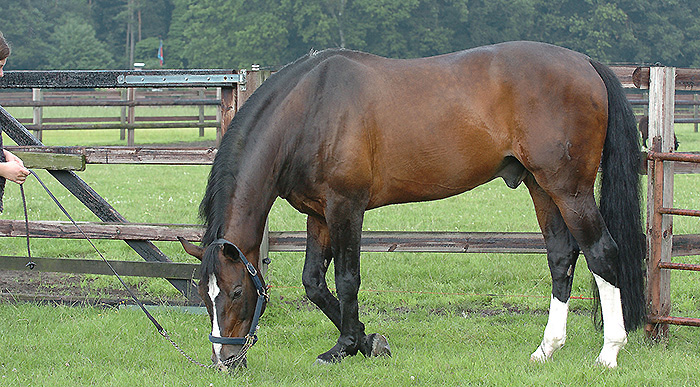
Voltaire at home at the Greve Stud, he died not long after
Voltaire appears on the 2015/16 KWPN breeding values in 43rd place with a value of 126 (98%). He has produced 2749 progeny over the age of four, with 908 registered for competition (33.03%). On the 2016/17 KWPN standings, Voltaire has moved to 40th, with 2756 progeny over 4, and 914 competitors (33.16%). He has a jumping value of 125, conformation – 103, free paces – 99, free jumping – 107.

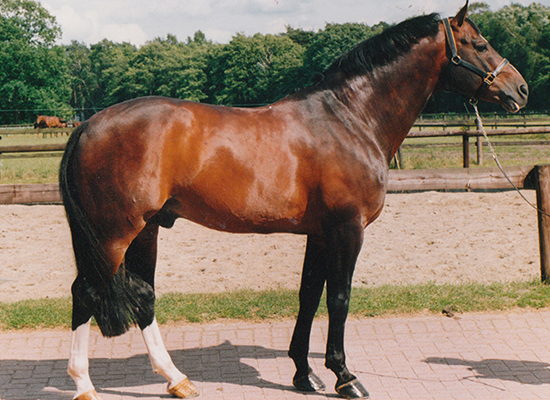
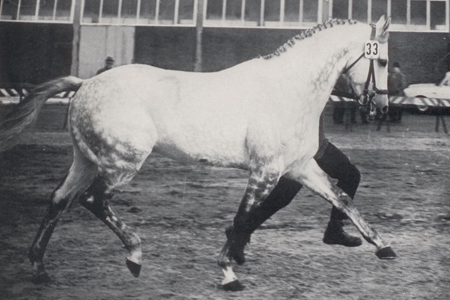
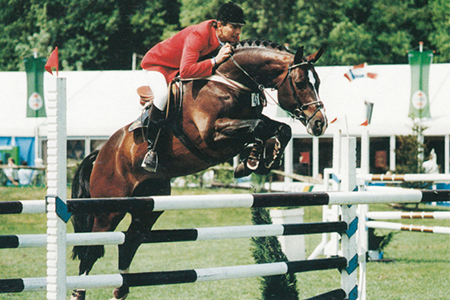
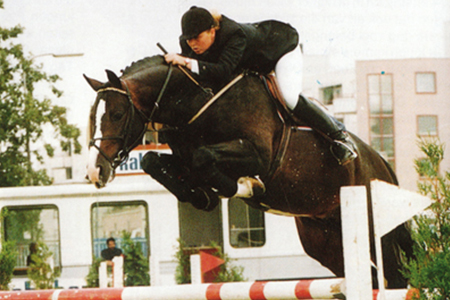
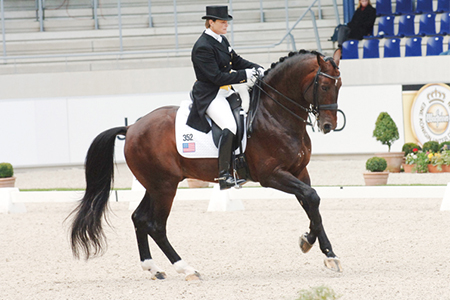
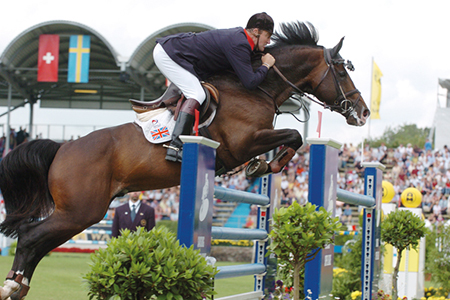
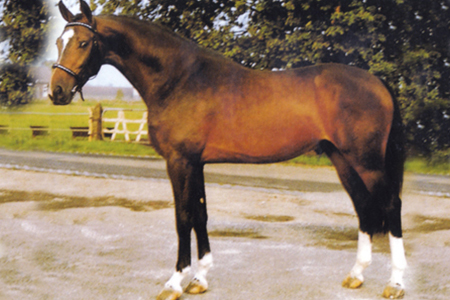
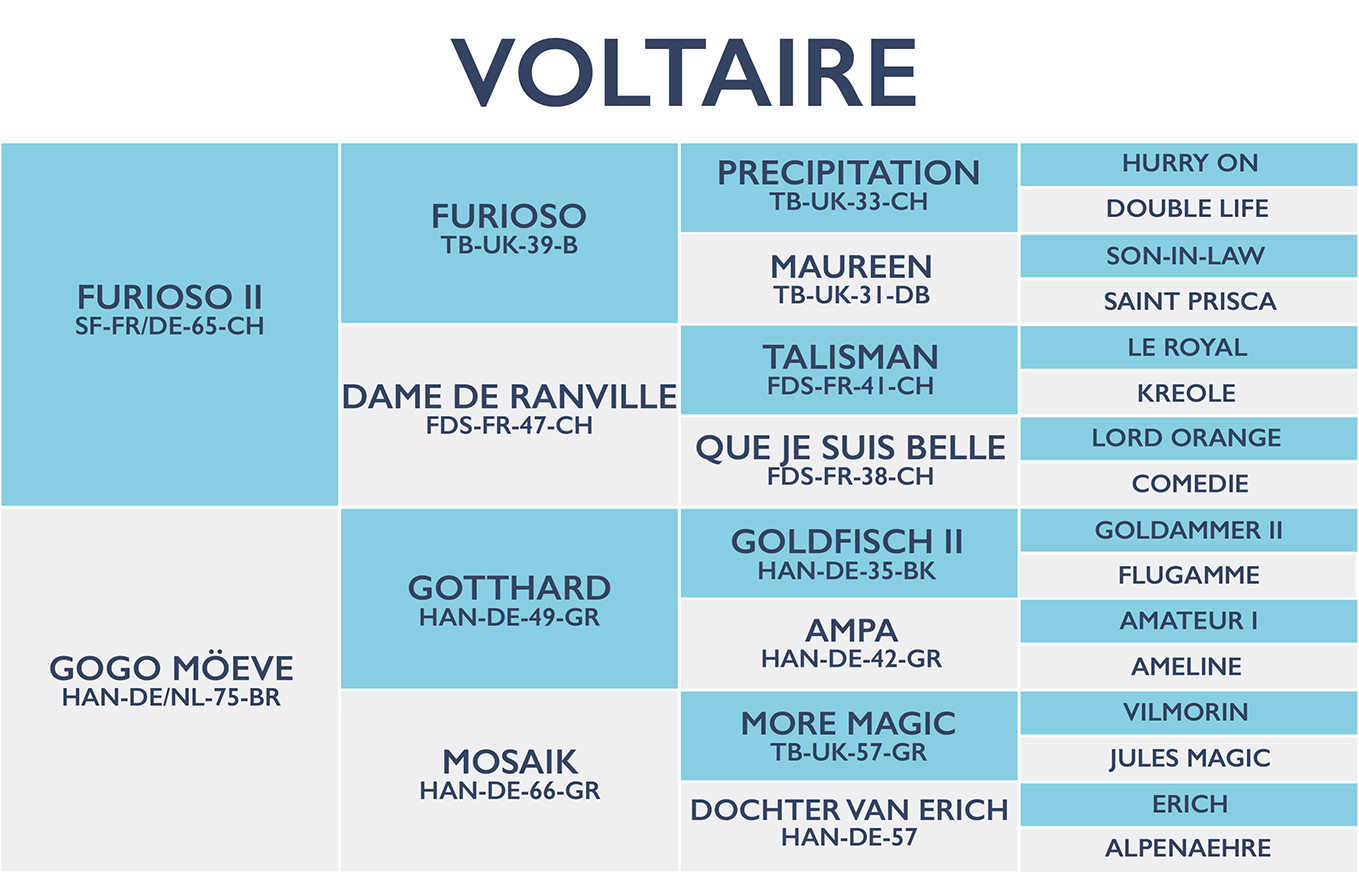
Very enlightening and beneficial to someone whose been out of the circuit for a long time.
– Kris
My KWPN gelding is by Voltaire and I can attest to the stellar temprement. I doubt I’d ever have as sweet and compliant a horse again. He has competed in Dressage, since I imported him 8 1/2 years ago. He looks remarkably like his papa! I’m so glad Voltaire was “found” and bred!